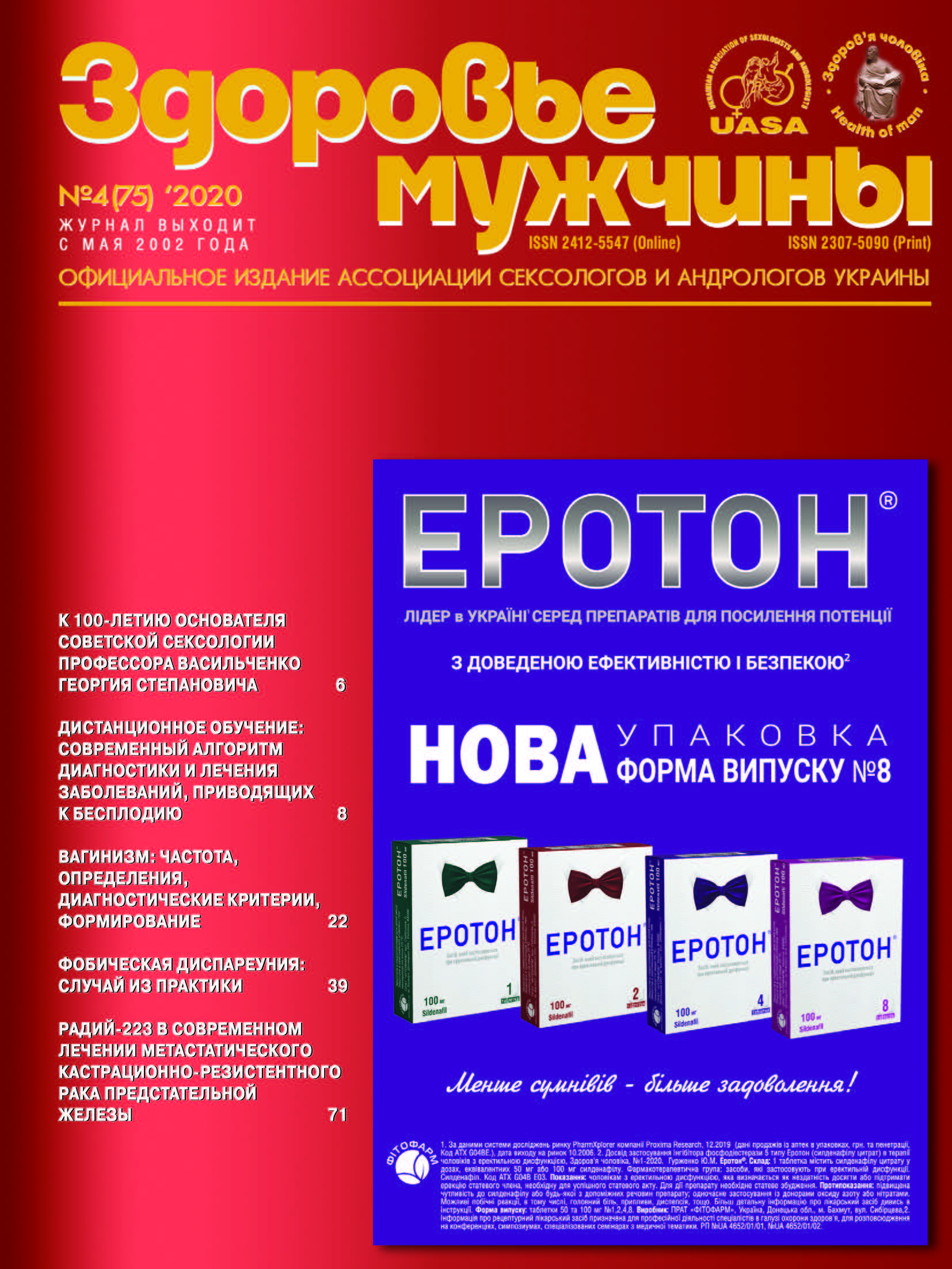Modern Methods of Treating Erectile Dysfunction in Young Men
##plugins.themes.bootstrap3.article.main##
Abstract
Traditionally, the incidence of erectile dysfunction (ED) increases with the age of a man, evolutionarily protecting him from passing on old, defective genes to his offspring by limiting his participation in sexual activity. Nevertheless, in the modern world, only 1 % of sexual contacts are carried out for the purpose of reproduction, the rest – with a recreational and social purpose. In addition, there has been an increasing number of cases of ED in young men lately. The problem of treating ED in young patients (up to 45 years old) requires an etiological approach.
The objective: to determine the effectiveness of etiological non-surgical (treatment of prostatitis, psychotherapy) or minimally invasive (Marmara operation, veno-occlusive surgery, PRP-therapy) treatment of young men with ED.
Materials and methods. On the basis of the Kharkiv Regional Medical Clinical Center for Urology and Nephrology named after V.I. Shapoval and on the basis of the P. Mogila Black Sea National University (Nikolaev) during 2014–2020. a comprehensive examination and treatment of 563 patients was carried out, which were divided into three supergroups (A, B and C) according to the prevailing factor: 156 patients with venoocclusive erectile dysfunction – supergroup A, 353 patients with chronic prostatitis – supergroup B and 54 patients with predominant psychoneurological disorders and the absence of organic pathology - supergroup C.
Results. The effectiveness of surgical treatment in supergroup A according to subjective data after 2 months was almost equal in groups and subgroups, but after 18 months it was significantly higher in subgroups 1b and 2b (65.4 % and 83.7 %) according to ICEF results, and according to objective data after 18 months – 73.4 % and 91.4 %, respectively. After 1 and 7 months, the effectiveness of treatment in supergroup B was determined by the indices of satisfaction with sexual intercourse on the IIEF scale, the number of patients satisfied with the results of treatment, the absence of prostatic complaints and the eradication of infectious agents. Convincing results were obtained when assessing the quality of life of patients in supergroup C.
Conclusion. Chronic prostatitis is the most common cause of erectile dysfunction ED in young men. Three-week antibacterial etiological treatment demonstrates the highest rates of infection eradication and ICEF recovery in patients with prostatitis. Operation Marmara reduces venous hyperemia of the prostate, lowers the IPSS score, and improves erectile function in patients with comorbid pathology. The use of an etiological approach allows to improve the sexual function of young patients, returning them to a normal sexual life, creating an alternative to falloprosthetics.
##plugins.themes.bootstrap3.article.details##

This work is licensed under a Creative Commons Attribution 4.0 International License.
Authors retain the copyright and grant the journal the first publication of original scientific articles under the Creative Commons Attribution 4.0 International License, which allows others to distribute work with acknowledgment of authorship and first publication in this journal.
References
Chalyi ME, Akhvlediani ND, Kharchilava RR. Erectile dysfunction. Urologiia. 2017, 2 (supplement):20–9.
Vlachopoulos C, Ioakeimidis N, Rokkas K, Angelis A, Terentes-Printzios D, Stefanadis C, Tousoulis D. Acute effect of sildenafil on inflammatory markers/mediators in patients with vasculogenic erectile dysfunction.Int J Cardiol. 2015 Mar 1;182:98–101.
Pezzoni F, Scroppo FI Penile vascular diagnostic categorization using penile duplex Doppler ultrasound: Differences in vascular hemodynamics parameters by differences in anatomic sampling location..Arch Ital Urol Androl. 2016 Oct 5; 88(3):183–185. Epub 2016 Oct 5.
Keller JJ, Chen YK, Lin HC. Varicocele is associated with erectile dysfunction: a population-based case-control study. J Sex Med. 2012 Jul;9(7):1745–52.
Losordo DW, Dimmeler S. Therapeutic angiogenesis and vasculogenesis for ischemic disease: part II: cell-based therapies. Circulation. 2004; 109(22):2692–7. https://doi.org/10.1161/01.CIR.0000128596.49339.05.
Lee Shin-Jeong, Kim Kyung Hee, Yoon Young-sup Generation of Human Pluripotent Stem Cell-derived Endothelial Cells and Their Therapeutic Utility Curr Cardiol Rep.;20(6):45. doi:10.1007/s11886-018-0985-8.
Takakura N. Discovery of a Vascular Endothelial Stem Cell (VESC) Population Required for Vascular Regeneration and Tissue Maintenance Circ J. 2018 Dec 25;83(1):12–17. doi: 10.1253/circj.CJ-18-1180. Epub 2018 Nov 28.
Lee SJ, Sohn YD, Andukuri A, Kim S, Byun J, Han JW, et al. Enhanced therapeutic and long-term dynamic vascularization effects of human pluripotent stem cell-derived endothelial cells encapsulated in a nanomatrix gel. Circulation. 2017; 136(20):1939–54. https://doi.org/10.1161/circulationaha.116.026329
Adams WJ, Zhang Y, Cloutier J, Kuchimanchi P, Newton G, Sehrawat S, et al. Functional vascular endothelium derived from human induced pluripotent stem cells. Stem Cell Reports. 2013; 1(2): 105–13. https://doi.org/10.1016/j.stemcr.2013.06.007. [PubMed: 24052946]
Taura D, Sone M, Homma K, Oyamada N, Takahashi K, Tamura N, et al. Induction and isolation of vascular cells from human induced pluripotent stem cells – brief report. Arterioscler Thromb Vasc Biol. 2009; 29(7):1100–3. https://doi.org/10.1161/atvbaha.108.182162. [PubMed: 19423866]
Rufaihah AJ, Huang NF, Kim J, Herold J, Volz KS, Park TS, et al. Human induced pluripotent stem cell-derived endothelial cells exhibit functional heterogeneity. Am J Transl Res. 2013;5(1): 21–35. [PubMed: 23390563]
Orlova VV, van den Hil FE, Petrus-Reurer S, Drabsch Y, Ten Dijke P, Mummery CL. Generation, expansion and functional analysis of endothelial cells and pericytes derived from human pluripotent stem cells. Nat Protoc. 2014; 9(6):1514–31. https://doi.org/10.1038/nprot.2014.102. [PubMed: 24874816]
Wu Y, Chen L, Scott PG, Tredget EE. Mesenchymal stem cells enhance wound healing through differentiation and angiogenesis. Stem Cells. 2007; 25(10):2648–59. https://doi.org/10.1634/stemcells.2007-0226. [PubMed: 17615264]
Mulyasasmita W, Cai L, Dewi RE, Jha A, Ullmann SD, Luong RH, et al. Avidity-controlled hydrogels for injectable co-delivery of induced pluripotent stem cell-derived endothelial cells and growth factors. J Control Release. 2014; 191:71–81. https://doi.org/10.1016/j.jconrel.2014.05.015. [PubMed: 24848744]
Bahk JY, Jung JH, Han H, Min SK, Lee YS. Treatment of diabetic impotence with umbilical cord blood stem cell intracavernosal transplant: preliminary report of 7 cases. Exp Clin Transplant. 2010 Jun;8(2):150–60.
Капто А.А. Клинические аспекты сосудистой анатомии у пациентов с варикоцеле (лекция) // Экспериментальная и клиническая урология. – 2016. – № 2. – С. 70–79.





